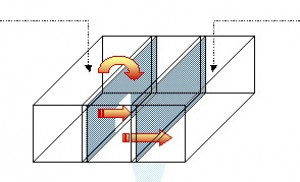Within a warehouse composed of 8 storage units rented by 4 different operators, fire broke out in bales of cellulose wadding stored in one of the units, while another occupied by the same operator was used as a workshop for sanitary paper products. The accident occurred subsequent to works carried out with a blowtorch on the roof of the building.
Employees arrived on the scene with a fire hose cabinet; however, in 20 minutes, the fire had spread via the roof and existing wall openings to the second unit occupied by the operator. The partial collapse of a partition wall allowed the fire to spread to a third unit occupied by another operator, where agro-pharmaceutical products and animal feed were being stored.
Despite water supply difficulties, external fire-fighters were able to control the blaze in 2 hours; 37 members of the fire-fighting crew experienced discomfort due to smoke inhalation and 7 were hospitalised for testing. The other five units were preserved thanks to the intervention of emergency services. Onsite property damage was estimated at 15 million francs (€2.29 million).
During the emergency response, a total of 1,500 m³ of fire extinction water carrying phytosanitary products, detergents and soaps were collected in a permeable stormwater overflow basin, polluting the basin’s underlying ground and threatening an aquifer and potable water catchments.
In light of the refusal of the various operators to comply with prescriptions set forth in successive prefectural orders issued following the accident and the litigation proceedings initiated, requisition measures were adopted in order to quickly resume the pumping, storage and treatment of fire extinction water, as well as the installation of 2 piezometers to monitor the water table.
The requisition of subcontractors made it possible to complete the necessary works, with treatment extending over 11 months. The definitive financial settlement of operations was overseen by the party or parties responsible for the accident and its consequences, with their delays only serving to increase the total cost of required operations.
The quick spreading of this fire recalls the importance of a well-adapted construction code and the need for impermeable retention basins (whenever applicable) by unit / operator (depending on the products stored). Moreover, in a configuration featuring interconnected installations run by different industrial operators, it is critical to verify that all technical and organisational questions related to pollution and risk prevention have been addressed by appropriate measures, whose implementation has been clearly assigned.
Download the detailed report in .pdf format (170 Kb)




